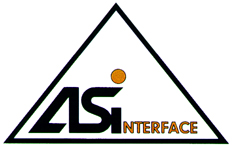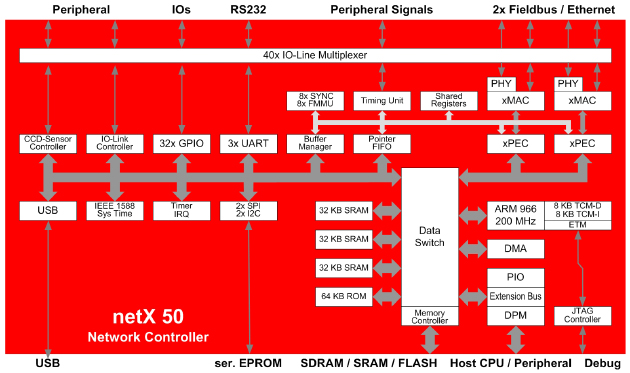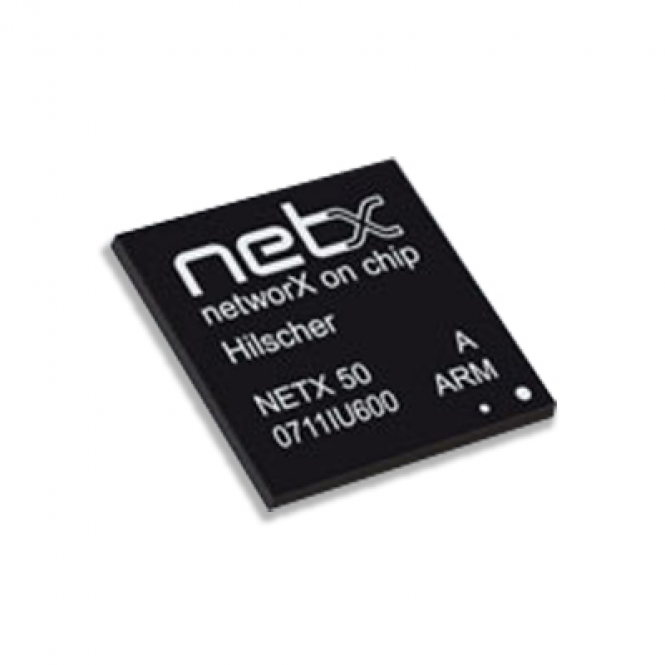© 2013 Uwe Wannags Hard-+ Software Distribution e.K (SWD)
HIL-NETX50
NETX 50


| netX 50 Network Controller The netX is a highly integrated network controller with a new system architecture optimized for communication and maximum data throughput. Via an integrated dual-port memory it works as an companion chip to a host CPU and realises the complete scope of industrial communication from fieldbus systems up to the Real-Time Ethernet systems. Allows the application no own CPU the host interface can be configured as Extension Bus or directly as digital input and output. The 32-Bit CPU ARM 966E-S is clocked with 200 MHz and has 112 KB internal RAM and 64 KByte ROM memory. The memory can be expanded flexible by the 32-Bit memory controller with SDRAM, SRAM or FLASH externally. Extensive periphery functions, serial interfaces such as UART, USB, SPI, I²C, as well as the integrated IO-Link and CCD controller allows a large scope of applications. The central data switch and the free configurable communication channels with its own intelligence are the unique selling proposition of the netX as an “high end” network controller. The data switch connects via five data paths to the ARM CPU and the communication, Host and DMA controllers with the memory or the peripheral units. In this way the controllers transmit their data in parallel, contrary to the traditional sequential architecture with only one common data bus and additional bus allocation cycles. The controllers of the two communication channels are structured on two levels and are identical to each other. They consist of dedicated ALUs and special logic units that receive their protocol functions via Microcode. For Ethernet the PHYs are integrated which means that the external circuit for Ethernet is reduced to passive componets: transformer and RC components. The Medium-Access-Controller xMAC sends or receives the data according to the respective bus access process and encrypts or converts these into Byte depictions. The Protocol Execution Controller xPEC compiles these into data packets and controls the telegram traffic. Large data amoutns are exchanged in DMA blocks over the memory of the ARM. In addition, every channel has a Dual-port-memory available for status information. Alternatively a triple buffer logic is implemented for a conflict free data exchange which always gives the address of the next free buffer. With the intelligent communication ALUs, the netX carries out the most varied protocols and protocol combinations on one chip – an absolutely new feature in industrial communication technology. |
Facts at a glance:
|
|
|
|

| Product | NETX 50 | |
|---|---|---|
| Description | netX 50 Network Controller | |
| Computer Core | ||
| Processor | ARM 966E-S, 200 MIPS, ARMv5TE-command set with DSP-extension | |
| Tightly Coupled Memory | 8 KByte Data 8 KByte Instruction |
|
| Internal memory | ||
| RAM | 96 KByte | |
| ROM | 64 KByte with Bootloader | |
| Ethernet interface | ||
| Ports | 2 x 10BASE-T/100BASE-TX, Half-/Full-Duplex, IEEE 1588 time stamp | |
| PHY | Integrated, Auto-Negotiation, Auto-Crossover | |
| Real-Time-Ethernet | EtherCAT with eight FMMUs and eight Sync-Manager Ethernet/IP Modbus IDA Powerlink with integrated Hub PROFINET RT and IRT with integrated Switch SERCOS-III |
|
| Fieldbus-Interface | ||
| fieldbus | The systems can be freely combined. AS-interface, Master only CANopen, Master and Slave CC-Link, Slave only DeviceNet, Master and Slave PROFIBUS, Master and Slave |
|
| Peripherals | ||
| IO-Link Controller | 8 Channels, automatically direction control | |
| CCD-Sensor Controller | max. 50 MHz, 640x480 Pixel, free configurable data format | |
| IEEE 1588 System Time | 32-bit second counter, 32-bit nanosecond counter | |
| USB | Revision 1.1, 12 MBaud Full-Speed, Host- or Device-Mode | |
| UART | 16550 compatible, max. 3 MBaud, RTS/CTS support Quantity 3 | |
| I²C | Master and Slave mode, 50 KHz up to 3.4 MHz, 16-bit FIFO, Quantity 2 | |
| SPI | Master- and Slave-Mode, max. 10 MHz, 3 Chip-Select-Signals | |
| General I/Os | 3.3 V / 6 mA Quantity 32 |
|
| Status LEDs | 2 LEDs dual colored, 3.3 V/9 mA, Quantity 2 | |
| Memory-Interface | ||
| Memory bus | 32 Bit-Databus/24 Bit-Address bus | |
| Address region | 256 MByte SDRAM/64 MByte FLASH | |
| Memory modules | SDRAM, SRAM, FLASH | |
| Host-Interface | ||
| Dual-Port-Memory Mode | 8 / 16 / 32-Bit-Databus, configurable, emulated by internal RAM | |
| Extension-Mode | 8/16 Bit-Databus, 24 Bit-Address bus, Bustiming adjust table | |
| PIO-Mode | Freely programmable Inputs and Outputs | |
| Debug-Interface | ||
| JTAG | ARM-Processor and Boundary-Scan | |
| ETM | Embedded Trace Macrocell, ETM9 V2 Medium Size | |
| Operating Requirements / Housing / Miscellaneous | ||
| System cycles | 200 MHz ARM / 100 MHz Periphery | |
| Signal level | 3.3 V | |
| Power supply | 1.5 V for the core 3.3 V for Input/Output |
|
| Operating temperature | without heat sink –40..+70 °C with heat sink 10°/W –40..+85 °C |
|
| Storage temperature | -65°C..+150°C | |
| Power consumption | PHYs switched off 0.8 W PHYs switched on 1.2 W |
|
| Housing | PBGA, 1 mm raster 324 Pins Dimensions 19 x 19 mm |
|
Copyright 2014 - Hilscher
Rev: 01/19
 Did you forget your password?
Did you forget your password?


